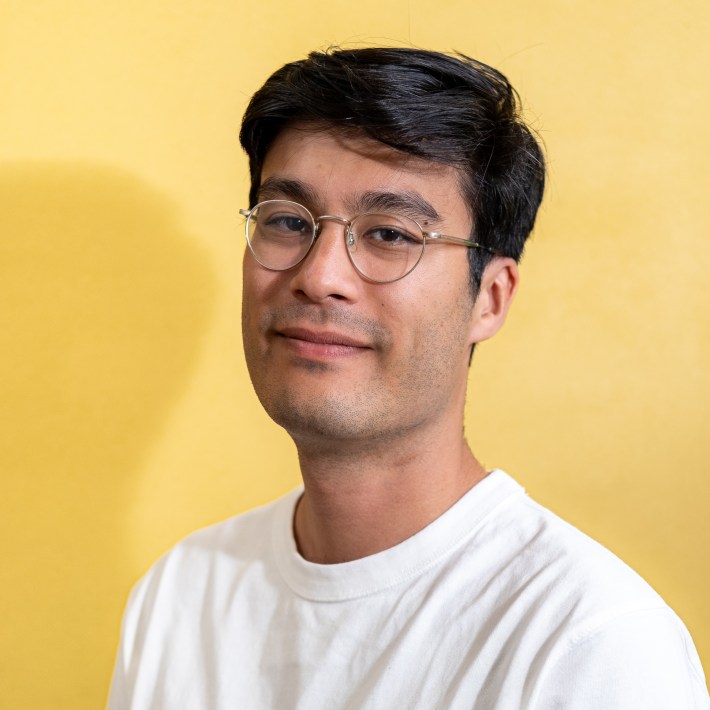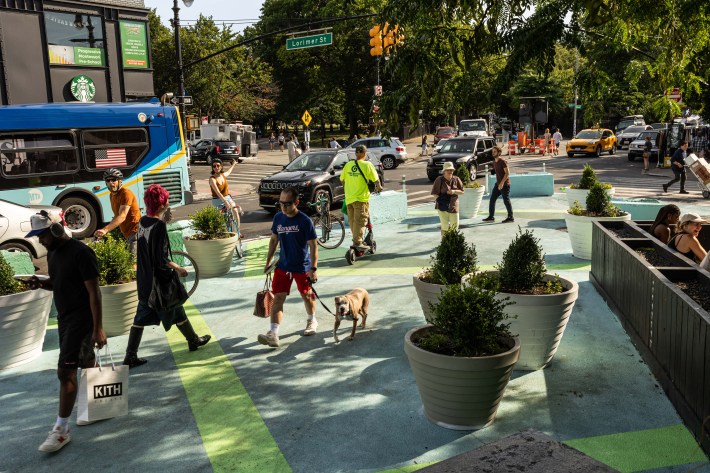Is New York City bland?
At a recent conference, I heard a group of out-of-town planning professionals lament the “sameness” of the Big Apple’s public spaces. The same planter, metal chair and colorful paint job can be seen in spaces from Corona to Crown Heights. In fact, you can see the same designs in Detroit, San Francisco and Philadelphia, too. What’s the point of being in New York City if you can squint and think you’re in Denver?

It may seem frivolous to care about the distinctiveness of public space when we simply need more of it. But even the most jaded public space advocate can admit we’re doing well here when it comes to quantity. Since the Bloomberg era, the DOT Plaza Program has created over 100 new plazas. After the pandemic began, Open Streets and Open Restaurants showed that we can rapidly create public space. Each of these programs has its ups and downs, but the overall trend is in the right direction.
But quantity isn’t quality. An Open Street is often little more than two metal barricades, a plaza may consist of only asphalt paint and concrete blocks. Elevating these barebones spaces into distinct places is more important than one might think. Sociological studies show our sense of belonging and "place attachment" are influenced by local landmarks and positive public social interactions. A good public space can provide both — rooting people to each other and their neighborhoods.
So how can a cash-strapped city help foster what I call “contextual public places,” places that reflect and create neighborhood identity and inspire that special feeling of belonging? The answer can’t simply be “better” design when the entities responsible for public space continue to fight for adequate funding. More than that, it’s people who most directly animate a space. The easiest way to make public space reflect its neighborhood is by programming it to attract locals.
I’ve spent this summer hanging out in two Brooklyn plazas that use programming to create and reflect neighborhood identity. Ave C Plaza in Kensington serves as a sitting area after prayers at the local mosque, a rehearsal space for children to practice Mexican folk dances and an outdoor stage where I recently heard musicians performing a mash-up of Bangla and Jewish folk songs. Up north in Greenpoint, the Bedford Slip Plaza captures the spirit of environmental activism, eclectic small businesses and even the neighborhood's vintage-leaning fashion sensibility. These spaces both use the standard DOT toolkit, yet I couldn’t imagine either of them in any other neighborhood. And while a lot of what I just described happens on its own a lot of it is intentionally encouraged by local organizers.
I imagined people behind these plazas were like creative directors, dreaming up and putting on programming. But the key to a contextual public space is not to invent from scratch. Instead, the spaces’ organizers nurture and spotlight the culture and activity happening organically around them. Many of the performers who enliven Ave C Plaza met because their kids attended the local public school. When the Plaza opened, organizers were able to turn that informal network into a vast well of talent. Many of the volunteers who run Bedford Slip are also involved in local environmental and mutual aid groups, which have supported events in the temporary space. These deep, complex neighborhood networks elevate these places into true neighborhood hubs.

We can do more as a city to support this kind of work. DOT knows it’s not a grassroots programmer, and wisely partners with community groups to invigorate its plazas with culture and activity. The department’s Public Space Equity Fund has opened funding to programmers who work outside areas covered by wealthy business improvement districts or conservancies. But issues remain: Most funding is expense reimbursement, and the city is often late in paying. One organizer I spoke with racked up credit card debt for an event thinking the city would repay them the following month. When the city was late, they had to take out a loan to pay down their organization’s debt.
Most agencies that provide funding for programming require applicants to be nonprofits. While the intent of this requirement makes sense, forming a nonprofit is a prohibitive step for many. A music group may perform for money at a local venue while also wanting to perform in public space for free. Such a for-profit group would be disqualified from applying for city funding. In many cases, grassroots programmers must convince a local non-profit to apply on their behalf if they want to access city funds. A lot of this funding is also structured to support one-off events vs year-long programming calendars. We should design funding to support regular grassroots programming in public spaces, with funding for multi-year periods and the allowance of formal fiscal sponsors for applicants who can’t become non-profits.
Finally, the city could help solve some of the physical constraints on programming. Storage is a big concern. All the art supplies, instruments, tables, and chairs have to go somewhere once an event is over. At the very least, the city could subsidize storage units for plaza partners, but they could also partner with designers and groups like Art Built and Street Labs to design mobile plaza storage units, shade structures, collapsible stages, and other commonly requested street furniture. Creating a marketplace of pre-approved furniture, like what’s been done with Open Dining structures, would give partners a greater range of assets beyond the ubiquitous metal chair. The city should also take consistent programming into account when it decides which plazas get capital upgrades.
By empowering grassroots programmers we can ensure that New York City's public spaces do more than just fill a functional need. They can become vibrant, distinctive locales that resonate with the unique spirit of their communities, ensuring that every corner of the city maintains its distinct flavor and fosters a deep sense of place.






